Cocoon is an otherworldly puzzle videogame that creates complication by exploring innumerable variations on similar puzzles. Just when I think I’ve seen every permutation of a puzzle, it produces another. If asked, I would struggle to describe what Cocoon is about. I play as a bipedal beetle whose wings double as their arms. I guide them through multiple environments where curious and unexplainable things happen. There is a linear narrative that follows the player character undergoing some kind of transformation, but the details and purpose of this process go unexplained. All I can discern is that to complete the player character’s metamorphosis, I must guide them through about five hours of puzzles involving spheres and the many receptacles in which they may be placed.

Cocoon’s abstruse plot and seemingly-simple puzzles may sound unappealing as I have described them. What makes it worth playing is it contains some of the most expertly constructed puzzles I have encountered in many years. Multiple times while playing, I exclaim “wow” when I realize how a puzzle is to be solved. If everything else in Cocoon is meaningless, its clever and multi-layered puzzles make it a must-play.
I quickly understand that Cocoon emphasizes simplicity and intuitive learning. At no point am I given plain instructions on how to control the player character or what they should do next. I accomplish all their goals through inference by experimenting with interactable objects and scrutinizing environmental clues.

In Cocoon’s opening moments, a beam of light shoots from out of space and illuminates a hairy onion suspended from a cliff face. The onion’s hairs peel away and its subsurface opens in a suggestively obstetric fashion, revealing the player character who emerges into a dry, red canyon. I assume immediate control of the player character, but find their capabilities limited. They can be moved with the joystick and, with a press of the confirm button, flex the wings on their back. I press every other button on the controller in succession to no effect. I wonder if more buttons are utilized later. They are not.
Steering them with the joystick, I guide the player character down some rocky steps deeper into the canyon. There, they discover a switch on the ground. I place the player character on this switch, then press and hold the confirm button. This activates the switch, and a nearby rock folds itself into a ramp, creating a new path forward. These are the tools the player character utilizes in every subsequent puzzle: Movement and activation. Only placement, timing, and context change the puzzle’s solution.
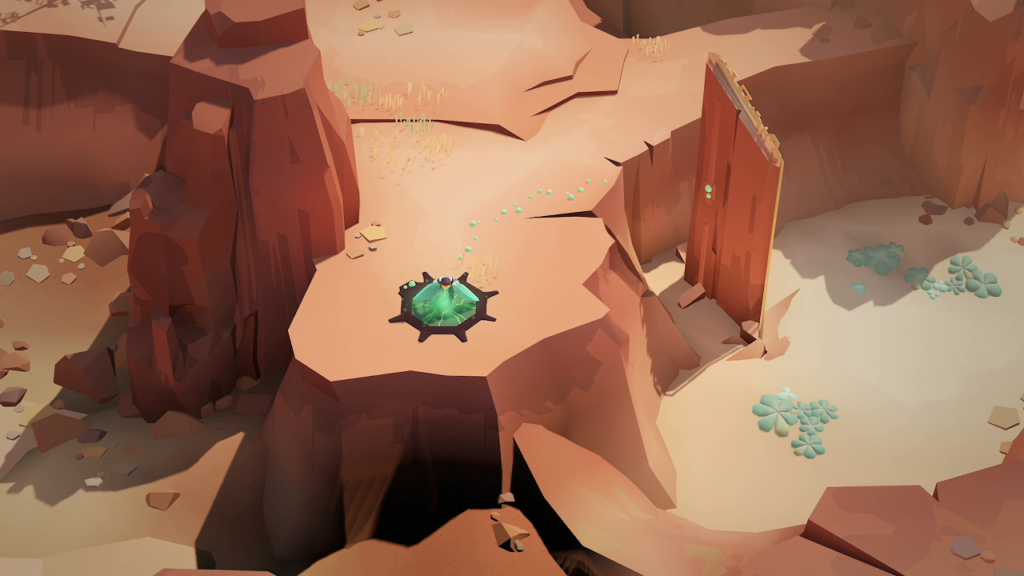
After discovering how to move and activate objects, I guide the player character through several more simple puzzles. More ramps are unfolded. Doors are opened. Floating platforms are ridden. At the end of this series, the player character discovers a pedestal. When they stand on it and I press the confirm button, they are launched upward, and they emerge from an orange sphere into a quite different environment. This new place is cold, mechanical, and grey, a stark contrast to the dusty red canyon.
A statue in front of the player character comes to life. It’s a moth-like construct with four white lights shining like eyes. Twelve crystals emerge from its wings and orbit around it. It stretches its wings and legs and arches its back with a low, grinding groan, then dissolves into ash. The player character remains trapped in the statue’s circular altar until they pick up the orange sphere from its pedestal. Once it’s hoisted onto their shoulders, a stairwell appears, and they are allowed to explore the rest of the area.

The puzzles which allow the player character access to the rest of the machine space are similar to what they found in the canyon, but now incorporate the orange sphere. When it is placed in a receptacle, it generates power which allows a switch to be activated. It can be dropped into a chute that carries the sphere beyond a barrier the player character cannot pass. This opens a passageway and the puzzle now becomes reaching the sphere again.
After several of these puzzles, the player character discovers another pedestal like the one that delivered them to the machine space. This one is a bit different; it contains a receptacle to hold the sphere. After placing the sphere inside, the player character activates the platform, and finds themselves diving back into the orange sphere, landing on the pedestal that sent them to the machine space.

I have sometimes been accused of being too open in describing the videogames I review, of being too much of a “spoiler.” I respond that in many mediums, and particularly in videogames, knowing some specific details does not detract from the experience of the moment, and may make the reader more likely to experience that moment.
I think of this year’s The Legend of Zelda: Tears of the Kingdom. It has a system for connecting objects together that is even more robust than it first appears, especially when many parts with unique mechanical functions are added to Link’s constructs. Describing that Link can use this system to build a machine which carries him into the clouds is not the same thing as doing it. It omits the learning process, the many foibles and pratfalls Link suffers during the process, and the ultimate structure that succeeds in the task which is unique to my knowledge and aptitude. Two different players build a machine that carries Link into the clouds. How they arrive there will be different, often dramatically so.
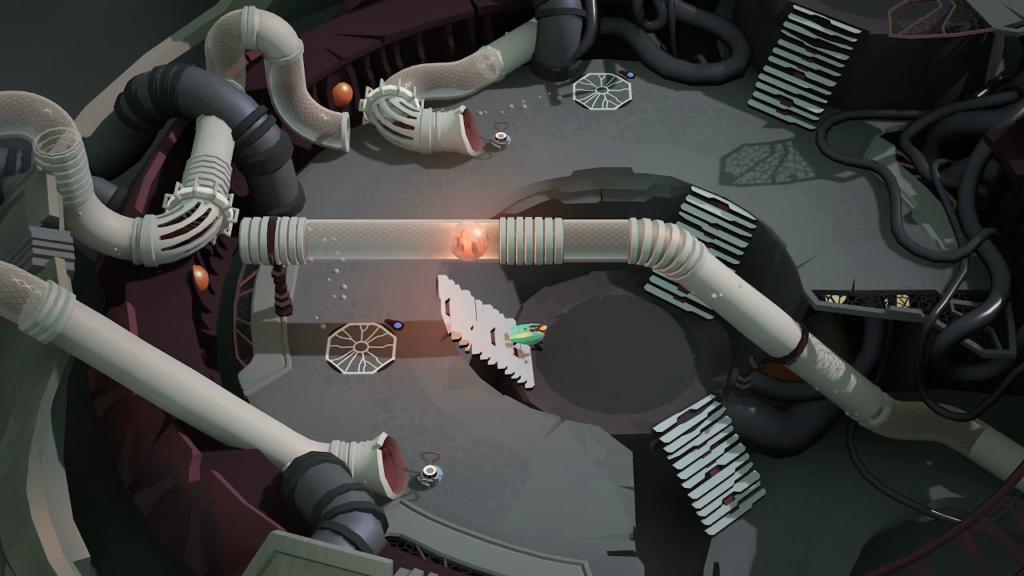
I can “spoil” what happens in a videogame, but the path the player takes to get there and the understanding that path bestows about those events is unique to that player. This is how two people can play the same videogame and come to two separate conclusions. I cannot describe my feelings about a videogame without describing my unique playing experiences, and a reader should not presume that their experience will be identical. Don’t complain to me about “spoiling” a videogame, because I have only spoiled my own time with it. That is the point of a review, and I will respond by thanking you for reading my work and encourage you to read more.
But in the exceptional case of Cocoon, I am receptive to the argument. What I have described thus far is little more than the opening ten minutes of about five hours of crafted puzzles. Much of the enjoyment I derive comes from my surprise at the new layers it builds on top of these introductory moments. These puzzles are rudimentary. The player character never becomes more complicated than movement and activation. But without my understanding of these basic components, I will be unable to solve any of the puzzles which follow.

So I feel that here I should urge the reader to stop and skip down to the concluding paragraph unless they still need to be convinced. In the remainder of the review I will go into more granular detail about all the wonderful things Cocoon does. I worry this will make them less wonderful. They may also make Cocoon more enticing for the unconvinced.
After solving a few more puzzles which involve leaping back and forth between the canyon and the machine space, I am surprised to find that Cocoon hosts what could accurately be described as a boss fight. The player character walks out onto a pillar sitting high above a hazy chasm and the moth-like statue from earlier reappears.
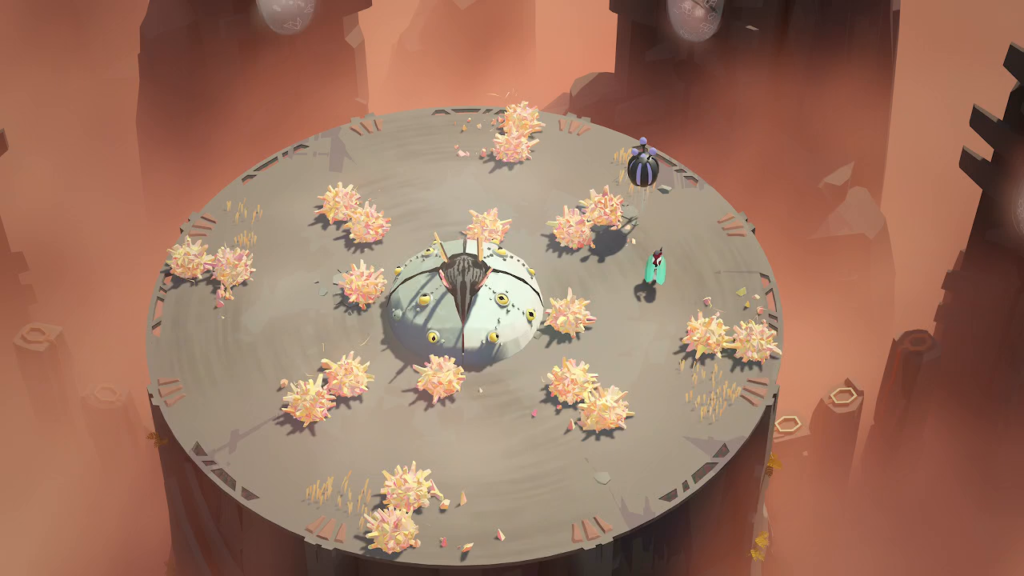
Because of the player character’s limitations, this boss fight is kept simple. The moth-figure swoops around the battlefield, letting loose the crystals from its wings which leave temporary tracks in the ground. If the player character touches them, they are booted back up to the machine space and must dive back into the orange sphere to try again. The player character must survive a gauntlet of swirling crystal patterns long enough to strike the boss several times with spheres which burst with energy when I hold the confirm button. Up until this point, Cocoon has been a sedate and cerebral experience. This boss battle tests my reflexes more than my reasoning.
Once the moth-figure is defeated, the player character returns to the machine space where the orange sphere has gained a new ability. It now emits an energy field that reveals hard light bridges projected by special mechanisms. With this new power, the player character is able to hoist the orange sphere on their back and continue on a new path. Several more puzzles follow, now incorporating the hard light bridges. They culminate in another pedestal, another statue that comes to life, and another sphere. This one is green, and yes, the player character soon finds a way to leap inside it.
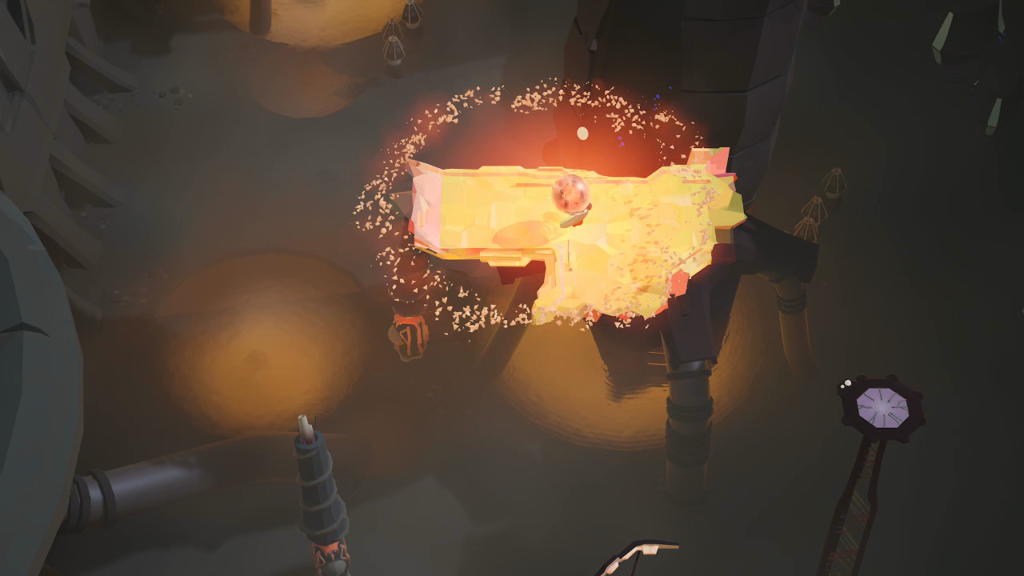
This is the point where Cocoon fully reveals itself. The player character navigates between multiple worlds, each represented by colored spheres which may be entered and exited using special pedestals. The many ways these concepts are explored is Cocoon’s true genius.
The way the worlds interact becomes recursive. The orange sphere must be carried into the green sphere to solve a puzzle. The green sphere must be carried into the orange sphere to solve another puzzle. When the green sphere’s boss is located and defeated, it too gains a new power. A blue sphere is discovered, it has a boss, and it has a unique power. Every sphere is eventually carried into another. At one point, a sphere must be placed inside a second sphere which is placed inside a third sphere, with the player character leaping through all three in turn, all to open a door. In a mind-shattering moment, the player character somehow finds a way to carry the green sphere inside itself. When this happens I can barely grasp a logical sense of what is happening long enough to solve the necessary puzzle. These moments are Cocoon at its most breathtaking and audacious. My fear is revealing them in this review detracts from their greatness.
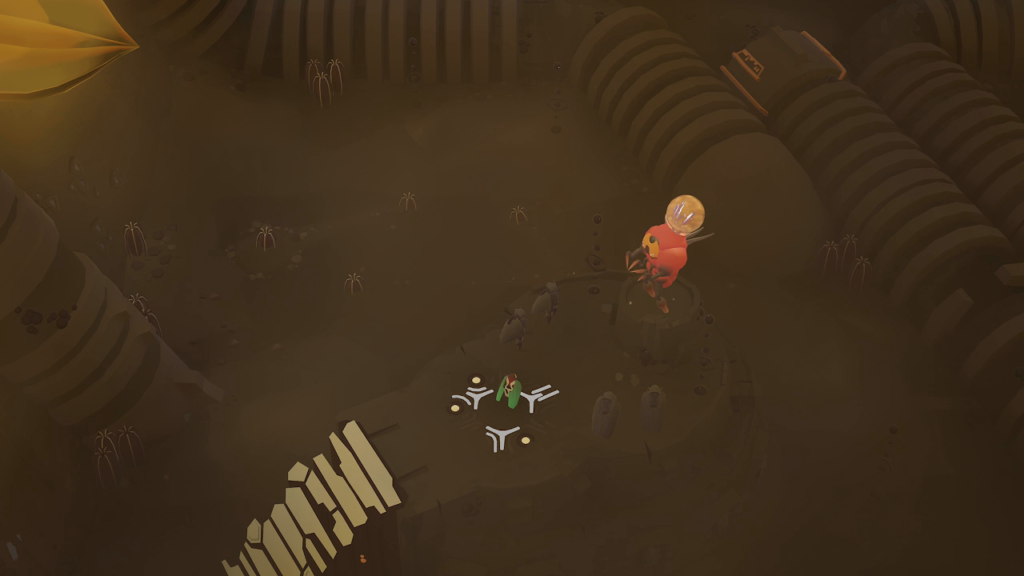
At different points along the player character’s path to their unknown goal, they encounter Moon Ancestors. These strange figures are located just off the direct route, the paths leading to them hidden behind scenery or camera angles, their presence hinted at by pillars made from jet black orbs. Solving a simple puzzle lets the player character interact with the Moon Ancestor, who rocket themself off into the sky. There are eleven total, and collecting all of them unlocks an expanded, but no less opaque, ending.
The Moon Ancestors feel like the most disappointingly traditional part of Cocoon. They’re a videogame collectible, necessary for one hundred percent completion and a secret ending, a rote and predictable addition to a videogame that builds itself on brilliant and original puzzle solving. When I reach the regular ending, I am allowed to backtrack to any point to search for any Moon Ancestors I missed, then fast-forward back to the ending. It only takes a few extra minutes to do this deed and I feel no sense of accomplishment for doing so. If Cocoon has a weak point, it’s the Moon Ancestors, but they are inoffensive at worst.

It’s difficult for me to describe how good Cocoon is without getting into details that are best left as a surprise. I like to get into details. It’s in the name of this website. But engaging too critically with Cocoon in the act of a review does its prospective player a disservice. There are few other videogames I can think of which I feel should be played unburdened by knowledge. The less you know about Cocoon going in, the more I believe you will enjoy it. If you read this entire review, I hope I haven’t ruined it for you. If you jumped down to this conclusion from the midway point, I hope my prosaic description of the basics doesn’t discourage you. On its surface, Cocoon is an ordinary puzzle videogame. It is the depth and complexity of its puzzles, built on recursive concepts and layered worlds, which make it one of the year’s best indie releases.